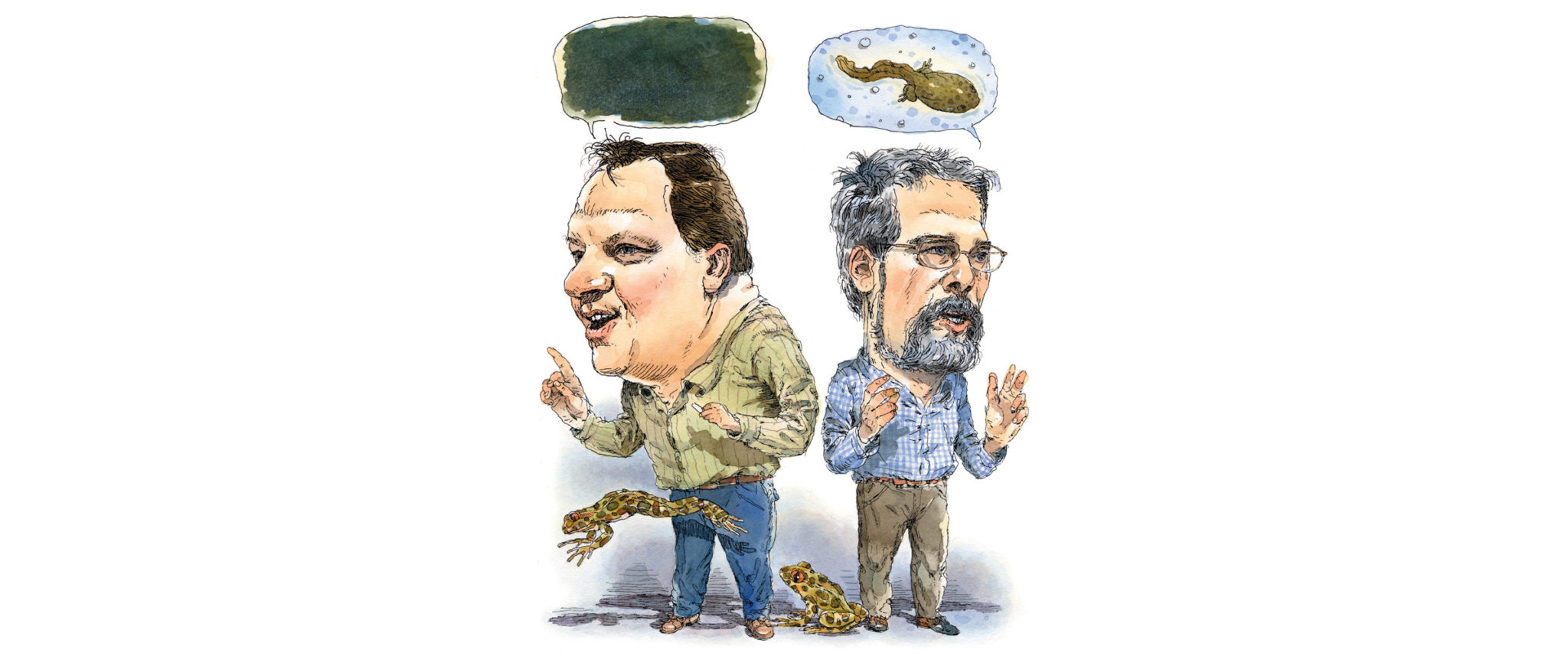It was back in 1999, at the weekly Faculty Lunch Series, when
biology professor Eric Liebl first heard philosophy professor Mark Moller speak about the ethical issues of reproductive technologies. They got to talking, as scholars do, and Moller took up Liebl’s invitation to speak to his Developmental Biology class about the ethics of stem cell research.
And they kept talking. They went to the University of Chicago as a biologist/ethicist team for a conference on biomedical ethics, and soon after formed what’s known at Denison as a “learning community,” in which two professors teach on a similar subject from their respective disciplines and challenge students to make the connections. In this framework, Liebl and Moller address an issue that means either medical salvation or moral ruin for large factions of our society. Their insightful, humorous, and stirring approach has since become a hit in the classroom and on Denison’s alumni lecture circuit. But no matter the audience, their objective remains the same: blend the scientific knowledge with the philosophical perceptions and let their students decide what is right and what is wrong. The following pages represent Denison Magazine’s humble attempt to translate their classroom experience into an almost-as-good read. As for the right and wrong of this piece and the matters at hand, well, that’s for you to decide.

ERIC LIEBL,
the biologist
In order to moderately understand the field of stem cell research, we need to understand the vocabulary. So, as we all know—or as we all should know—human fertilization occurs when the egg meets the sperm, up in the fallopian tubes somewhere. At that point, two nuclei—one from the egg and one from the sperm—fuse together into a zygote, which is basically a single-celled embryo.
Of course, the zygote is then going to start dividing into two cells, then four, and so on. When it reaches 16 to 32 cells, it becomes the morula. And getting to the morula stage is a big deal in human development. We’ll be dealing with that a bit later.
The next important stage is the blastocyst, when the embryo consists of maybe 250 cells. This is the first point, since that single-cell zygote stage, where we see cell differentiation. The cells on the outer layer of the blastocyst are called the trophoblast, which become the embryo’s contribution to the placenta. The cells on the inside are called, conveniently enough, the inner cell mass, and they become the actual embryo.
Why is that important? Well, when we’re talking about stem cell biology, we have to clearly address what are called the potencies of these different cell types. The zygote—the single cell that’s the root of all the parts of the embryo—is what is called totipotent. Being totipotent means it can become any tissue, and it has potential to eventually become a person.
Cells coming from the inner cell mass are called pluripotent. They can form all of the tissues of an embryo, but they’re not totipotent. They cannot form a trophoblast. And so, cells from the inner cell mass, embryonic stem cells, can’t make embryos. They can make all the parts of an embryo, but researchers can’t obtain a viable embryo from an embryonic stem cell because it doesn’t have the capacity to make a placenta.
Later, we’ll also address adult stem cells. They come from later stages of development—even cells from a fetus are considered adult stem cells. And they are most often characterized as what’s called multipotent. They can become things that are closely related, but they’re a little bit more restricted in their developmental potential. For example, a stem cell from my skeletal muscle might be able to make cardiac muscle.
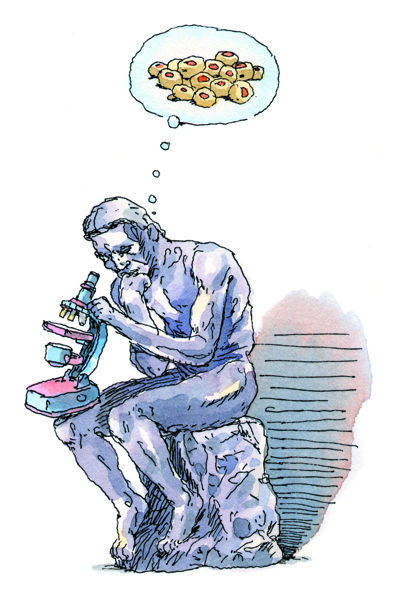 { THE MATTER OF EMBRYONIC STEM CELLS }
{ THE MATTER OF EMBRYONIC STEM CELLS }
Scientists who want to make embryonic stem cells would never be able to find an early blastocyst in a fallopian tube. Instead, those fertilizations have to happen in vitro. That’s mixing sperm and an egg in a petri dish. And from the blastocyst, scientists harvest cells from the inner cell mass and culture them in a petri dish under special conditions that allow them to remain pluripotent. Those conditions for human cells were first developed in 1998, which makes this an extremely young field of biological science.
So now we have pluripotent cells that can become many different parts of the body, fostering hope for the creation of a whole new field, called regenerative medicine. Embryonic stem cells offer amazing promises and therapeutic benefits. Say, for example, that I destroy my liver with a number of lifestyle issues; maybe I can get new liver cells from embryonic stem cells for organ replacement. Or take Parkinson’s disease, where patients lose dopamine-secreting neurons and develop tremors. If doctors could inject these patients with new dopamine-secreting neurons, maybe they could suppress those tremors. Or for people who can’t make insulin, maybe we could grow stem cells that cure insulin-dependent diabetes. There’s great promise out there for regenerative medicine.
What most people don’t realize is that there is another equally impressive field revolving around the hope that embryonic stem cells can offer models of disease in the laboratory. For example, if we could grow in the laboratory embryonic stem cells that are predisposed to developing Parkinson’s disease, then we could watch the disease process from start to finish. Learning what happens in those early steps might provide leverage for effective intervention efforts, pharmaceutical or otherwise. People are just as excited by the ability to make models of diseases as others are to use embryonic stem cells for regenerative medicine.
There’s also the issue of embryonic stem cell availability. Some people argue that lots of embryos are available for research, since in vitro fertilization has become fairly common. Often, more embryos are made than actually are used, and reputable sources estimate that there are at least 400,000 frozen embryos that were created for in vitro fertilization and fertility treatments. They are socked away, and most of them are going to be destroyed as medical waste or simply frozen for so long that they are no longer viable. Even if you implant them into a properly primed uterus, they wouldn’t develop into viable embryos.
The argument has been made that with all these embryonic stem cell sources out there, why don’t we just push ahead and do the research that could help people? Well, that’s where Mark comes in.
Organic Stimulus; To increase the supply of organs, Spain, Austria, Belgium, and Singapore now authorize the re-use of organs from dead bodies unless the deceased or their familes have submitted formal objections.

MARK MOLLER, the philosopher
{ INALIENABLE R IGHTS }
As a philosopher, I worry about these kinds of questions—about what limits should be placed on technologies that scientists like Eric develop. To determine that, we have to explore why there is controversy about this science.
At least initially, some of us would say that we have a moral obligation to pursue research that has significant potential to diminish human suffering and save human lives. That sounds awfully uncontroversial, right? Most of us would say, “Heck yeah! We want to diminish the suffering of others, and, frankly, our own suffering, too.” And given the overwhelming potential of embryonic stem cell research, it’s not surprising that many scientists want to pursue it at almost any cost.
But then we face the crucial question: Does using embryonic stem cells for research destroy a person in the process? It’s really the question of whether that morula on the head of a pin has the same moral standing as the adult human being who is reading this magazine.
Why is that relevant? Well, as a philosopher, I study arguments. I try to examine their various positions and tease out the persuasive premises and conclusions. I think many would accept an argument with the following two premises: All persons have certain basic rights. And two of these basic rights are the right not to be killed and the right not to be used as mere means to an end.
 Many of us are going to accept that these rights limit any obligation of beneficence we have. The classic example is harvesting organs from a healthy adult to save five others, or any number of others. So, suppose Eric, because of his lifestyle choices, ends up damaging his liver someday. He would really like a liver transplant, right? So why don’t we take the liver from you and give it to him? Or what if we take the liver from a homeless person and give it to him? In fact, we could take many other organs from that homeless person and save other lives.
Many of us are going to accept that these rights limit any obligation of beneficence we have. The classic example is harvesting organs from a healthy adult to save five others, or any number of others. So, suppose Eric, because of his lifestyle choices, ends up damaging his liver someday. He would really like a liver transplant, right? So why don’t we take the liver from you and give it to him? Or what if we take the liver from a homeless person and give it to him? In fact, we could take many other organs from that homeless person and save other lives.
Many of us would say that we can’t do such a thing, because we think that homeless person, or Eric, or any other person has certain rights that trump, in this case, our obligation of beneficence. We’re not going to take my liver and give it to Eric, because even though we could help him, I have a right that cannot be violated. If you accept this, you’re going to accept the argument that medical research is never justified if it violates either of these basic rights. So it would seem that if embryonic stem cell research harms a person, then we ought not to participate in it, or else we should be incredibly hesitant to do so.
{ A QUESTION OF PERSONHOOD }
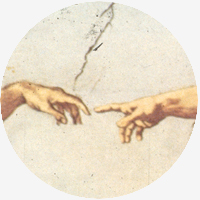 Why do we think of the embryo as a person? One of the religious arguments is ensoulment. Many people believe that ensoulment occurs at the moment of conception, and many think that having a soul defines personhood. If you agree, then you’ll probably want to grant whatever rights I have to an embryo because both enjoy the same moral status.
Why do we think of the embryo as a person? One of the religious arguments is ensoulment. Many people believe that ensoulment occurs at the moment of conception, and many think that having a soul defines personhood. If you agree, then you’ll probably want to grant whatever rights I have to an embryo because both enjoy the same moral status.
A second religious principle is that God is the creator of human life, and creation occurs at conception. At this moment a new, unique human life exists. In this case, whoever believes that life starts at conception is going to claim again that a zygote has the same moral status as a person. So research on the zygote is subject to the same limitations as research done on me.
But even if you don’t accept one of the religious arguments, you might accept nonreligious arguments along the same lines, the first being that the human zygote has the natural potential to become a human person. Remember that an embryo in a petri dish can be placed in a woman’s body, provided that she’s prepared in the right sorts of ways, and in most cases that embryo is going to develop into a fetus. If you think about it, that the embryo has all that it needs to develop into a person - it just has to unfold this potential. Nothing has to be added except nutrition. So if it is a person at the end, it must be a person at the beginning.
A second nonreligious argument is one that has to be taken very seriously, because history is full of examples when we have mistakenly denied personhood to human beings. Many people say that it is better to err on the side of caution—to grant every human being personhood—than to err by denying it. It’s an argument that’s to at least be considered, whether or not it’s ultimately persuasive.
If you accept any of these arguments, you’re most likely going to be against stem cell research because you’re going to say the embryo is a person with the same basic rights that you have, and therefore we ought not to experiment on it. And we ought not to harvest stem cells from it, because that requires destroying the embryo.
I’m not saying, by the way, that these arguments are right or wrong. I’m describing them because I think it’s important to understand why people hold the views they do. People like me have been spending decades trying to come up with theories of personhood. Frankly, I don’t think we’re ever going to agree on the personhood of embryos or fetuses. Ultimately, I think that how the issue is decided for political purposes will depend on who’s elected.
{ POTENT POLITICS }
 Somewhere between viable forms of embryonic stem cell research and the controversy surrounding it is the question of whether people who embrace arguments favoring personhood of embryos will accept attempts to get around the controversy.
Somewhere between viable forms of embryonic stem cell research and the controversy surrounding it is the question of whether people who embrace arguments favoring personhood of embryos will accept attempts to get around the controversy.
When George W. Bush was elected president, he faced pressure to come up with a policy about embryonic stem cell research that walked the line between opposing views. He had the one group saying we have a moral obligation to pursue embryonic stem cell research—it’s the great discovery of the 21st century. Others said we can’t pursue it because the research is evil—it’s the misuse and abuse of human persons. In August 2001, Bush announced a new policy on federally funded embryonic stem cell research that remains in effect today.
In his speech, Bush acknowledged that embryonic stem cell research offers great promise to those who suffer from terrible diseases. But he also stated his belief that human life is a sacred gift from the creator, and that he worries about a culture that devalues life. He accepted a religious argument about personhood. But he did not ban the research altogether. Rather, he limited federal funding to just the 60 lines of stem cells that existed at the time. So, if you could get access to any of those lines, you could seek federal support for the research.
But there were problems. First, there were not 60 viable embryonic stem cell lines. There were more like 21. Second, organizations that own these stem cell lines were reluctant to ship and share them, because, let’s face it, once Bush stated the new policy, they became a precious commodity. Some also worried that these lines might be contaminated because the cultures were initially grown on layers of mouse cells.
So these embryonic stem cell lines are certainly not candidates for any sort of transference to human beings, and therefore, cannot be used for regenerative medicine. The risks would be too great. These stem cells also are not genetically diverse. Think about the kinds of people who have the money to pay for reproductive technologies. It’s really a very small portion of the population.
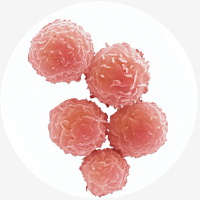 So if these stem cells were used for any kind of regenerative medicine, there would be serious problems with matching criteria for transplants. They’re not going to benefit a significant majority of people in the United States, because they’re just not genetically diverse lines.
So if these stem cells were used for any kind of regenerative medicine, there would be serious problems with matching criteria for transplants. They’re not going to benefit a significant majority of people in the United States, because they’re just not genetically diverse lines.
So it’s fair to say that Bush’s solution has effectively hindered embryonic stem cell research in the United States. It’s just too darn difficult to do it if you can’t get the lines.
{ FINDING FUNDING }
The biologist: Clearly, there are a lot of people dissatisfied with the current state of affairs. So now we’ll address ways that scientists find funding given the current restrictions in place. One easy way is to move to one of the few states that does fund embryonic stem cell research, or just leave the United States altogether. It’s what we call the “brain drain”—an awful lot of people are going to Britain, South Korea, Singapore, Japan, or China, where they’re performing very robust stem cell research. You can imagine that they see a lot of potential to turn around and sell that research back to the United States.
Many scientists are pursuing funding from deep-pocketed private foundations like the Howard Hughes Medical Institute and the Juvenile Diabetes Foundation, which funds some stem cell research at Harvard.
In addition, a number of states have raised bond issues to acquire money, the most famous being the California Stem Cell Initiative. The state has committed $3 billion over ten years to jump-start an embryonic stem cell research industry, with expectations that it will function as an economic driver.
But there are also efforts to make embryonic stem cells that will satisfy the current federal criteria. In other words, these would be cells that are pluripotent—we have to have pluripotency, that’s a given—and that also safely navigate around the argument of personhood.
First, we’ll look at embryonic stem cells derived from supposedly non-totipotent embryos
(I) EXTRACT A CELL FROM A MORULA
The biologist: Let’s revisit the morula stage of the embryo. Technology now enables scientists to extract just one of its 16 to 32 cells, leaving a perfectly viable embryo. But now we’ve taken a cell away from it, with hopes of using that cell to produce pluripotent embryonic stem cells. Of those 32 cells, some are clearly going to give rise to the inner cell mass, but some may have already been committed to forming the trophoblast.
The philosopher: The big question here is whether those single cells that are selected are totipotent, and there’s reason to think that they are. One-third of all identical twins form by a morula split. Given that, there’s a very good chance that that single selected cell could have the ability to develop into a human embryo. The only way to test totipotency is to take that cell, let it develop into a morula or blastocyst, and transfer it into a woman’s body. What we’re talking about here is a form of cloning. We would have twins, in this case, so it would be intentional cloning—intentional twinning. The Roman Catholic church specifically forbids intentionally splitting an embryo to make twins, so this has already been deemed morally illicit by a major world religion. So even testing for totipotency creates some controversy.
The biologist: This technique does produce patient-specific cells for the embryo, or person, who “donated” the cell, but only for that person. In other words, it doesn’t have clinical applications for anyone living now.
(2) MAKE AN EMBRYO VIA PARTHENOGENESIS
 The biologist: Parthenogenesis occurs when an egg can give rise to an embryo, without the contribution of sperm. It’s not common, but natural examples have been noted among whiptail lizards and male honeybees. That process became a model for scientists who were able to trick an unfertilized egg into developing as a normal human embryo from which embryonic stem cells could be extracted. Researchers have obtained human pluripotent stem cells from parthenogenesis.
The biologist: Parthenogenesis occurs when an egg can give rise to an embryo, without the contribution of sperm. It’s not common, but natural examples have been noted among whiptail lizards and male honeybees. That process became a model for scientists who were able to trick an unfertilized egg into developing as a normal human embryo from which embryonic stem cells could be extracted. Researchers have obtained human pluripotent stem cells from parthenogenesis.
The philosopher: Some people will accept that a genetically defective fetus, even though it can’t come to term, still has personhood. This parthenogenetic embryo could be defined as an embryo that’s genetically defective. So if you believe that personhood begins at conception, you might say that this embryo is no different from a genetically defective fetus at sixteen weeks gestation, and it deserves the same respect that any other embryo does. One study also demonstrated that mouse parthenotes were able to develop to adulthood, suggesting that under some conditions, parthenogenetically activated human oocytes, which are immature female eggs, might be totipotent. So this doesn’t seem to pass the test of avoiding the personhood argument.
The biologist: This method would yield patient-specific results for each woman who donates an unfertilized egg, but not men, girls, or older women.
(3) EXTRACT A CELL FROM A CHIMERIC EMBRYO
 The biologist: This technique, which actually has been done, involves obtaining eggs from non-human donors, namely rabbits and cows so far. If we can take out the egg’s nucleus, if we can remove its genetic material, we then have a vessel into which we can insert genetic material that has been taken from a patient. And then we can trick that egg into developing, and this might be a way to create embryonic stem cells.
The biologist: This technique, which actually has been done, involves obtaining eggs from non-human donors, namely rabbits and cows so far. If we can take out the egg’s nucleus, if we can remove its genetic material, we then have a vessel into which we can insert genetic material that has been taken from a patient. And then we can trick that egg into developing, and this might be a way to create embryonic stem cells.
The philosopher: I find that a little creepy. The embryo that results would always have some amount of DNA that is from the donor. Before you say, “Well clearly it’s not a person,” suppose these were totipotent embryos. Suppose you were able to transfer them into a woman’s uterus, and it came to term? Would you deny that being rights?
The biologist: This technique would yield patient-specific cells.
Now we’ll consider methods that use cells derived from sources other than embryos
(1) DERIVE ADULT STEM CELLS FROM DIFFERENTIATED TISSUE (SUCH BONE MARROW, UMBILICAL CORD BLOOD, ETC.)
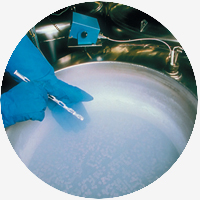 The biologist: Bone marrow transplant is a classic example of the therapeutic use of adult stem cells. I have stem cells in my hips. If I’m in a registry, and I have a genetic match to someone who has cancer, physicians will kill off the patient’s bone marrow, put me under, drill into my hips, suck up my bone marrow, and transfer it to the patient. Adult stem cells also can be harvested from the blood of a newborn’s umbilical cord.
The biologist: Bone marrow transplant is a classic example of the therapeutic use of adult stem cells. I have stem cells in my hips. If I’m in a registry, and I have a genetic match to someone who has cancer, physicians will kill off the patient’s bone marrow, put me under, drill into my hips, suck up my bone marrow, and transfer it to the patient. Adult stem cells also can be harvested from the blood of a newborn’s umbilical cord.
The Philosopher:The personhood argument is not in play here. I can give up my adult stem cells. It doesn’t kill me—it’s kind of like a living organ donation. But the real question here is whether or not those adult stem cells are in fact pluripotent. Most researchers believe that they are multipotent, that they don’t satisfy the pluripotent criteria. So that complicates their usefulness.
The biologist: This technique would yield patient-specific cells only for the adult stem cell donor.
(2) CULTIVATE SPERMATOGONIA CELLS
The biologist: In April 2006, some promising research reported that cells that divide to create sperm can be isolated from human male testicles and show pluripotency when placed in the right culture condition.
The philosopher: The cells could contribute to all tissues in the embryo, but did not cross the threshold of totipotency, so the personhood argument does not apply.
The biologist: This holds therapeutic promise only for the men who donate the spermatogonia cells, which are unlikely candidates for regenerative medicine because of that genetic incompatibility.
(3) DERIVE STEM CELLS FROM AMNIOTIC FLUID
The biologist: In the amniocentesis procedure performed during pregnancy, amniotic fluid containing fetal cells is withdrawn from around the developing embryo to test for genetic abnormalities. This same technique can extract cells that are then cultured and convincingly give rise to pluripotent cell lines.
The philosopher: These cells have not been tested for their totipotency, but the expectation is that they do not cross that threshold.
The biologist: These cells would have clinical value for the donor embryo, but like the morula donation, would not apply to anyone living today.
(4) DE-DIFFERENTIATE ADULT STEM CELLS
The biologist: By this method, a cell, such as a skin cell, is removed from an adult. Four genes are introduced to that cell using a modified virus as a delivery system that allows the genes to influence activity in those cells. Then these genes become active, or are expressed, which causes the adult skin cell to revert to its embryonic state, meaning it becomes pluripotent. It’s then called an induced pluripotent stem (iPS) cell.
The philosopher: The worry is that we might cross the line and end up with a totipotent cell. Most scientists discount this concern, but if it does occur then the personhood argument kicks back in. We’ll have something that’s going to be an embryo again, or at least have some status very similar to an embryo.
The biologist: This produces cells with therapeutic potential for the adult donor.
{ A BRIGHT BUT UNCERTAIN FUTURE }
The biologist: There are huge advances in this field virtually every month, so by the time this article is published, it might be out of date. But even in the face of this progress, nothing so far has changed the fact that embryonic stem cells are still considered the gold standard for research purposes. All of the other experimental cell types will have to be studied in parallel to embryonic stem cells. This point is emphasized every time a new way of generating pluripotent stem cells is announced. It remains unclear whether any of these newer techniques will, in the long term, eliminate the need to derive embryonic stem cells from embryos.
The philosopher: We don’t expect there to be an easy way out of this embryonic stem cell controversy. There’s still a lot of tension. A large number of people maintain the argument that we have a moral obligation to pursue this research to cure human suffering. But an equally strong branch says this is simply immoral, that the research commits violence against the rights of these embryos. Despite the uncertainties associated with the continuing pursuit of stem cell alternatives and the policies of a new United States presidential administration, we can promise one constant: Eric and I will continue to monitor the biology and philosophy of the field and share what we learn with the Denison community.

